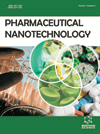- Home
- A-Z Publications
- Pharmaceutical Nanotechnology
- Previous Issues
- Volume 11, Issue 1, 2023
Pharmaceutical Nanotechnology - Volume 11, Issue 1, 2023
Volume 11, Issue 1, 2023
-
-
Nanotechnology: Newer Approach in Insulin Therapy
More LessAuthors: Pallavi Phadtare, Devendra Patil and Shivani DesaiInsulin is a peptide hormone released by pancreatic beta cells. An autoimmune reaction in diabetes mellitus type 1 causes the beta cells to die, preventing insulin from being produced or released into the bloodstream; that impacts 30 million people globally and is linked to shortened lifespan due to acute and chronic repercussions. Insulin therapy aims to replicate normal pancreatic insulin secretion, which includes low levels o Read More
-
-
-
Application of Electrospun Nanofiber as Drug Delivery Systems: A Review
More LessAuthors: Elham Vojoudi and Hamideh BabalooRecent advances in electrospinning have transformed the process of fabricating ultrafine nano-fiber scaffolds with side benefits to drug delivery systems and delivery systems in general. The extremely thin quality of electrospun nanofiber scaffolds, along with an effective area of high specificity and a stereological porous structure, capacitates them for the delivery of biomolecules, genes, and drugs. Accordingly, the pr Read More
-
-
-
Interpenetrating Polymer Networks of Polyacrylamide with Polyacrylic and Polymethacrylic Acids and Their Application for Modified Drug Delivery - a Flash Review
More LessAuthors: Marin Simeonov, Bistra Kostova and Elena VassilevaPolyacrylic and polymethacrylic acids, in combination with polymers such as polyacrylamide, provide the ability for controlled and sustained drug delivery since they represent pHand temperature responsiveness. In addition, the synthesis techniques can be used to develop a higher level of supramolecular structures as the interpenetrating polymer networks - as bulk hydrogels or micro-/nanogels. They can provide the oppor Read More
-
-
-
A Review on Polymeric Nanostructured Micelles for the Ocular Inflammation-Main Emphasis on Uveitis
More LessAuthors: Nikita Kaushal, Manish Kumar, Amanjot Singh, Abhishek Tiwari, Varsha Tiwari and Rakesh PahwaBackground: Various types of nano-formulations are being developed and tested for the delivery of the ocular drug. They also have anatomical and physiological limitations, such as tear turnover, nasal lachrymal waste, reflex squinting, and visual static and dynamic hindrances, which pose challenges and delay ocular drug permeation. As a result of these limitations, less than 5% of the dose can reach the ocular tissues. Obj Read More
-
-
-
An Exploration of Herbal Extracts Loaded Phyto-phospholipid Complexes (Phytosomes) Against Polycystic Ovarian Syndrome: Formulation Considerations
More LessAuthors: Ruchi Tiwari, Gaurav Tiwari, Shubham Sharma and Vadivelan RamachandranBackground: Herbal preparations with low oral bioavailability have a fast first-pass metabolism in the gut and liver. To offset these effects, a method to improve absorption and, as a result, bioavailability must be devised. Objective: The goal of this study was to design, develop, and assess the in vivo toxicity of polyherbal phytosomes for ovarian cyst therapy. Methods: Using antisolvent and rotational evaporation procedures, phyt Read More
-
-
-
Self-microemulsifying Drug Delivery System for Solubility and Bioavailability Enhancement of Eprosartan Mesylate: Preparation, In-vitro, and In-vivo Evaluation
More LessAuthors: Mukesh S. Patil and Atul Arunrao ShirkhedkarBackground: Formulations of eprosartan mesylate with a surfactant, like Kolliphor HS 15, an oil phase like Labrafil M 1944 CS, and a cosurfactant Transcutol HP by employing a liquid self-microemulsifying drug delivery system (SMEDDS) after screening several vehicles have been studied. Objective: This study aimed to prepare a liquid self-microemulsifying drug delivery system for increasing the solubility and bioavailability Read More
-
-
-
Modernization of a Traditional Siddha Medicine Paccai eruvai into a Novel Nanogel Formulation for the Potent Wound Healing Activity-A Phyto- Pharmaceutical Approach
More LessBackground: Paccai eruvai formulation has been widely used in traditional Siddha practice to treat ulcerous wounds due to the content of potentially active compounds. Objective: The present study aimed to determine the enhancement potency of wound healing of nanogels containing Paccai eruvai in an incision and excision wound models. Methods: Paccai eruvai nanogel was synthesized using the high-energy milling m Read More
-
-
-
Evaluation of the Antioxidant, Antidiabetic, and Anticholinesterase Potential of Biogenic Silver Nanoparticles from Khaya grandifoliola
More LessAuthors: Jude Akinyelu, Abiodun Aladetuyi, Londiwe S. Mbatha and Olakunle OladimejiIntroduction: In recent years, plant-mediated synthesis of silver nanoparticles has evolved as a promising alternative to traditional synthesis methods. In addition to producing silver nanoparticles with diverse biomedical potential, the biosynthesis approach is known to be inexpensive, rapid, and environmentally friendly. Objective: This study was aimed at synthesizing silver nanoparticles using ethanolic stem and root b Read More
-
-
-
Exosomes as Delivery Systems for Targeted Tumour Therapy: A Systematic Review and Meta-analysis of In vitro Studies
More LessAuthors: Suleiman A. Muhammad, Jaafaru Sani Mohammed and Sulaiman RabiuBackground: Delivery systems with low immunogenicity and toxicity are believed to enhance the efficacy of specific targeted drug delivery to cancer cells. Exosomes are potential natural nanosystems that can enhance the delivery of therapeutic agents for targeted cancer therapy. Objective: This study provides a precise effect size of exosomes as nanovesicles for in vitro delivery of anticancer agents. Methods: In thi Read More
-
Most Read This Month
Article
content/journals/pnt
Journal
10
5
false
en


